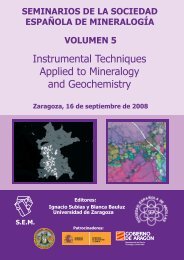XVI Reunión CientÃfica de la Sociedad Española de Arcillas - Libro ...
XVI Reunión CientÃfica de la Sociedad Española de Arcillas - Libro ...
XVI Reunión CientÃfica de la Sociedad Española de Arcillas - Libro ...
Create successful ePaper yourself
Turn your PDF publications into a flip-book with our unique Google optimized e-Paper software.
Galhano AC et al. / Comunicaciones SEA 2001 – Baeza (Jaén)<br />
Although improving engineering properties of soil by heating has long been<br />
appreciated theoretically, it has not been consi<strong>de</strong>red appropriate for engineering<br />
application because of the high energy cost. In the USSR, heating has been found<br />
to be as economical as prewetting or b<strong>la</strong>sting for treatment of loess. Both these<br />
methods are generally less expensive than using piles or caissons for treatment<br />
<strong>de</strong>pth up to 12 m (Lim 1981)<br />
Heating fine-grained soils to mo<strong>de</strong>rate temperatures (higher than 100ºC) can<br />
cause drying and strength increase if subsequent rewetting is prevented.<br />
Depending upon the soil type, heating to temperatures in the range of 300ºC to<br />
1000ºC can produce significant permanent property improvements such as a<br />
<strong>de</strong>crease in water sensitivity, swelling, and compressibility, and increase in<br />
strength.<br />
As stated earlier, the primary reason for the limited application of thermal<br />
stabilization by heating is the high energy cost associated with it. Hence, the<br />
general intent of this study is to enhance the current state of knowledge by<br />
offering a through un<strong>de</strong>rstanding of the effect of heating on soil properties, namely<br />
on c<strong>la</strong>ys with different mineral composition, stablishing a data base useful for<br />
<strong>de</strong>velopment of an effective and economical stabilization system.<br />
For this intent we have used about ten c<strong>la</strong>yey soils, of different sites of<br />
Portugal and we have submit them to several temperature ranges, between<br />
natural sample and a maximum temperature of 1000ºC. In each heating range<br />
were <strong>de</strong>termined some p<strong>la</strong>sticity properties, expandability and mineral<br />
composition with geochemical composition.<br />
In general terms the liquid limit and p<strong>la</strong>sticity in<strong>de</strong>x dropped slightly when<br />
heated up to 100ºC, stayed almost constant between 100ºC and 300ºC, and then<br />
dropped very rapidly when heated over 300ºC. The p<strong>la</strong>stic limit increased slightly<br />
when heated up to 200ºC, <strong>de</strong>crease slightly when heated between 200ºC and<br />
300ºC, and then increased slightly again between 300ºC and 400ºC. In some













